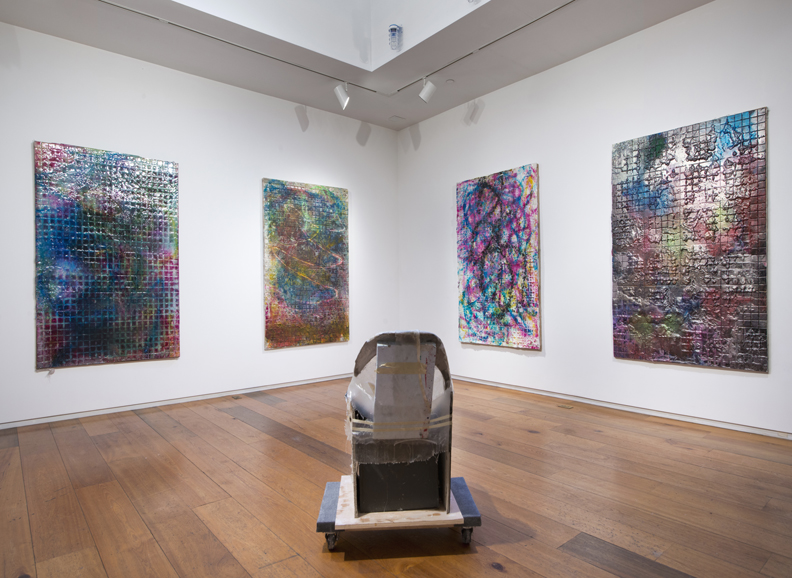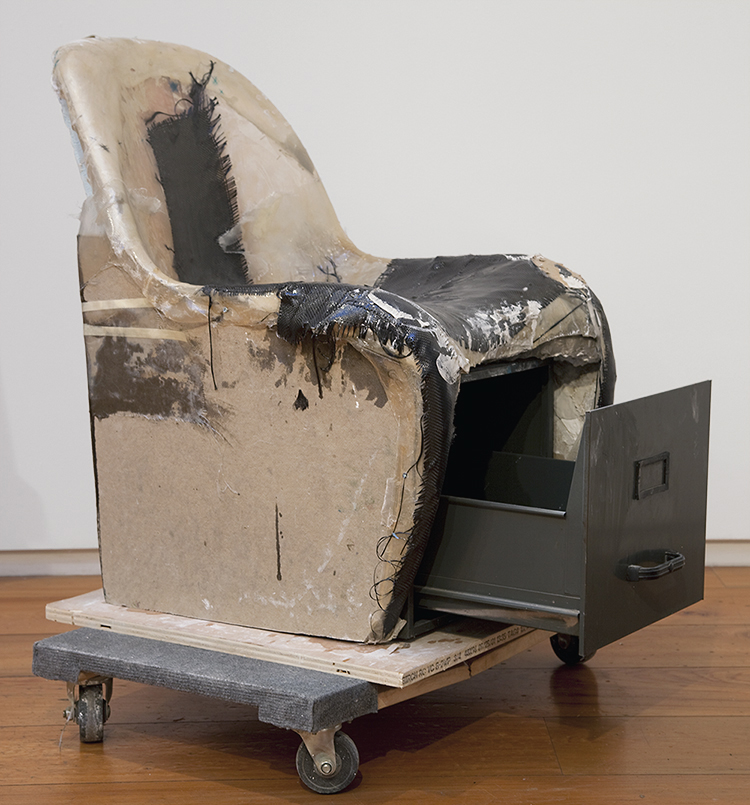
Installation View: Joel Holmberg, Soft Laws (2013), American Contemporary, New York
Some, such as John Michael Boling and Kevin Bewersdorf, have slowed down or halted their artistic practices to pursue careers in IT or other ventures, while others—say Aleksandra Domanović and Michael Bell-Smith—have enjoyed considerable success in the art market, both artists being represented by notable commercial galleries. Holmberg, the subject of this article, gained attention in 2010 for his existential-yet-slightly-trolling Legendary Account included in Free, curated by former Rhizome Executive Director Lauren Cornell. For Legendary Account, Holmberg asked the normally utilitarian Yahoo! Answers site questions such as “Does having a crummy day-job help stimulate your creativity?”, “Is it possible to jet ski or sea doo in the dead sea?”, or “How long does post-coital last?”. Holmberg and Cornell exhibited blown-up, printed documentation of the account at the New Museum, and the account is now archived on Rhizome’s Art Base.
Two years later, Holmberg studies at Yale’s Master of Fine Arts Program and has launched his first commercial gallery exhibition in New York at American Contemporary (previously Museum 52) in NoHo. Holmberg’s Soft Laws presents an array of sculpture divergent in size and material. We see a plaster-covered lamp shade, jib crane, fiberglass chair built on top of a filing cabinet, ceramic tile, pencil wall drawings, etc.—these works unified by their almost slapdash handmade nature and implicit sense of humor. While Holmberg’s humor has always been prevalent in his oeuvre, the heightened, studio-born materiality of his newer work may seem something of a new thing. Like his humor, connecting the artist’s process is his tendency to continually relate back to how our identities can be subsumed by clichés, platitudes, and larger systems of thought by the relationships and interactions that they script.
If Holmberg’s Legendary Account sought to de-script the Yahoo! Answers format by introducing the site to an air of jocularity and existentialism, his new sculptural works in Soft Laws exaggerate and re-script common artistic materials as well as the popular characterization of the artist. Take the painterly Emotional Bioré (2012), one piece in a series of five large wall-mounted works using ceramic tile as a base with plaster pushed through back to front—mimicking, the artist says, the functionality of backlit digital screens. Sourcing sheets of tile that have yet to grouted, Holmberg considers the medium of the tile to be a scripted material that prompts the user’s action (i.e., there are grooves between individual tiles, and they will only adhere to a surface if one grouts them, thus one must grout them. This effect isn’t terribly unlike the act of posting a status update to social networking sites in order for it to be liked. For example, I’m going to post a photo of myself smiling on the beach so that my friends will confirm how relaxed and tan I look.) Holmberg douses the plaster composition’s front with printer ink while it sets, imbuing it a saturated, CMYK feel. When splattered, the ink changes the topography of the plaster to appear similar to a lunar surface or Pollock-inspired drip, itself a scripted gesture pointing toward the bravado of the oft-drunk, late-Modernist abstract expressionist painter—perhaps pop culture’s favorite portrayal of the romantic, tortured artist.

Joel Holmberg, Verner Panton Chair with Filing Cabinet (2012)
Holmberg’s exhibition takes the eccentric story of distinguished French artist Jean-Pierre Raynaud’s tile house as fodder. After a divorce in 1969, Raynaud spent 23 years fitting every surface of his house with 15cm x 15cm white bathroom tiles. At first, the artist merely thought of the tiles as a utilitarian, easy-to-clean surface. Through either a twist of genius or bout of mental illness, the project soon became an obsessive exercise in sensory perception, the artist closing off the house to all visitors—including repairmen and friends—in 1988. Raynaud eventually chose to demolish it in 1993, in order to give it one last “audacious” breath of life by exhibiting it in stainless steel buckets. “The love story between me and the house has already lasted for 23 years,” Raynaud deadpans in a 1993 documentary on the house directed by French filmmaker Michelle Porte. “I have set it in time, in passion, in destruction, in reconstruction, like any couple living together.” Hundreds of stainless steel buckets filled with sledgehammered tiles were later shown in army-like grids at the CAPC musée d'art contemporain de Bordeaux. Porte’s documentary ends with a slow-pan throughout the show set to an operatic soundtrack, the buckets being dwarfed by the high-ceilinged architecture of the Bordeaux institution.
As one may expect, Holmberg isn’t exactly awe-inspired by Raynaud’s story, and is rather annoyed by the artist’s bloated, artist-as-outsider-genius affectation. Holmberg’s frustration with this all-too-familiar “kooky artist” mentality is clarified in the exhibition’s press release, written by the artist, stating, “We are used to hearing people described as being like an artist. Though I’ve yet to hear someone described as being an artist when it comes to time management, which might actually be what artists are best at…Isn’t it funny how one might advocate for a prickly person by saying that they are just ‘wired differently’? That can excuse a lot of difficult behavior.” Here Holmberg introduces a variety of outdated platitudes we use to make sense of artists and their relationships to the world. Being “like an artist” or “wired differently,” or, not to mention, spending 23 years tiling the inside of your house after a divorce denigrates the role of the artist—who now must be business, tech, and socially savvy—to that of a confused, emotionally unstable social outsider bearing little value to society.

Joel Holmberg, Thank You Note (2012)
While these clichés are carried via the currents of popular culture and mass media, (which may at times misleadingly feel a comfortable arms length away from the contemporary fine art world), Soft Laws evinces how embedded these insidious ideas have become in our artistic practices and interpersonal relations. Holmberg proves that identifying and breaking open such platitudes carves space for refreshing, personally tailored practices that are untethered by such spectral pressures.